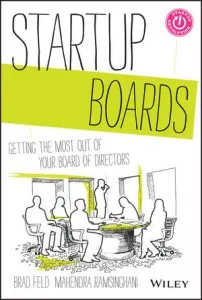Startup Boards: getting the most out of your board of directors

by Brad Feld and Mahendra Ramsinghani
2014 John Wiley; 19 chapters, 210 pages
Looking to understand how to appoint and leverage a board of directors and board of advisers for your startup? This book is an essential guide to the dynamics of a startup's boards, especially for founders about to seek funding or at the scale stage.
The authors advise entrepreneurs that establishing an objective outside group in the form of a board is essential for startups, especially to keep you on track, call you out when you flail, and in some cases, save you from yourself.
A well-chosen and smoothly functioning board can support startups, help understand milestones and get to them faster, and hold the management accountable. The 19 chapters in the book are based on the authors’ direct experiences, as well as interviews with over 40 directors and investors, and extracts from a dozen expert blogs.
Board issues covered range from meeting and interviewing to socialising and shuffling directors. Many tricky questions are raised and tackled: What is the ideal mix of a board? Does the CEO work for the board or is it the other way round? What is the role of founders on the board? What is the difference between influencing and dictating roles?
“Startup boards aren’t fancy, complex, or pretentious. Instead, a startup board is usually a small group of people trying to help build your company,” says Feld. “You should form your board early in the life of your company, regardless of how you are financed,” the authors advise.
The book shares best and worst practices, and provides checklists and tables for creating and managing an effective board. I have summarised some of the key issues and advice in the book in Table 1; the companion website of the book series has further resources.
Table 1: Choosing and Leveraging Boards
The role of board members changes at different stages of the startup’s growth: early stage (customer discovery, product development), revenue (strategy, sales) and growth (finance, HR, strategy). In terms of personality, the director can be the cheerleader, truth teller or domain expert, and is chosen for his or her experience, skills and networks.
An ‘ideal’ board of directors includes the CEO of the startup, investors, independent directors and other peer CEOs. Board observers and lawyers can also be useful additions. A good director is ‘strategically engaged but operationally distant’ from the working of the startup. Sometimes the CEO can step aside to become executive chairman of the board. An effective way for CEOs to understand the role of a director is to themselves serve as directors for other companies.
Occasionally, founders have retained both board-level control and economics that last through an IPO of the startup, and have been both ‘rich and king.’ This can be achieved through different classes of shares, and getting some shareholders to hand over voting rights to the founders (eg. in Facebook, Google, LinkedIn, Yelp, Zynga).
The book does a good job of showing the challenges in choosing the right director, and classifies them into ‘great, fair and terrible.’ Directors can help a startup think big but also kill the company. Founders should ensure that the directors have good experiences and references, and are not focused just on perks or the interests of their own companies. They need to be responsive and proactive and do more than just show up at meetings.
There can also be conflicts of interest as VCs invest in competing companies, or directors collude among themselves. Particularly trying times for a board are when decisions are made to fire CEOs (eg. if they don’t scale, or are not in line with strategy change, or have committed serious errors) or to replace directors (eg. bad chemistry, conflict of interest).
Classic examples in startup literature include the removal of Google CEO Eric Schmidt from Apple’s board when Android was planned or the removal of Apple’s entire board when Steve Jobs was brought back to the company.
In many cases, advisors or a formal board of advisors are also useful options for a startup. They bring in creative thinking, networks of contacts, and good ‘sounding boards’ for testing ideas which can be later pitched to directors.
The concluding chapters of the book deal with transitions during IPOs, sale of the company, or closing down due to bankruptcy.

The book is also packed with excellent advice from a range of CEOs and investors; a few of them are indicated below and are a good way to wrap up this review:“An excellent board can dramatically help an entrepreneur while a lousy board can sink a company.” - Craig Dauchy, Partner and Head of Venture Capital Group, Cooley LLP
“An active, involved, and engaged board is required for any startup. Learn how to do it right.” - J. Sanford (Sandy) Miller, General Partner, Institutional Venture Partners
“While board meetings should be helpful to entrepreneurs, many find them to be worthless and tedious. A high-functioning board is a real asset to a company's success." - Jason Mendelson, Managing Director, Foundry Group
“Unfortunately, many VCs have a hammer and the unfortunate nail is the CEO.” - Manu Kumar, K9 Ventures
Author profiles:
Brad Feld has been an early-stage investor and entrepreneur for over 20 years. He is founder of the Foundry Group in Boulder, Colorado, as well as Mobius Venture Capital and Intensity Ventures. Feld is also a co-founder of accelerator Techstars. His earlier books include Startup Communities: Building an Entrepreneurial Ecosystem in Your City and he is featured in an exclusive interview with YourStory (‘Do or Do Not – There is no Try!’).
Mahendra Ramsinghani has over 15 years of investment and entrepreneurial experience and has led investments in over 50 seed stage companies. He helped draft the underlying legislation for a fund-of-funds for the state of Michigan. His earlier book is The Business of Venture Capital and his articles and blogs have been published in ‘Forbes’, ‘MIT Technology Review’, ‘Thomson Reuters’, and the ‘Huffington Post’. His educational background includes a BE in electronics and MBA in finance and marketing from the University of Pune, India.







